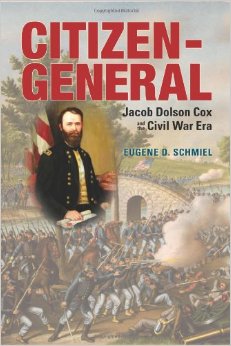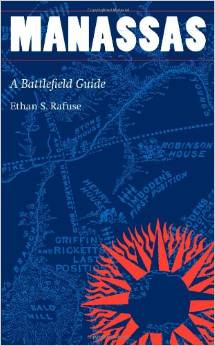Citizen-General: Jacob Dolson Cox and the Civil War Era by Eugene D. Schmiel. Ohio University Press, 2014. Paper, ISBN: 978-0821420836. $26.95.
 Mid-nineteenth century America can be considered the heyday of the gifted amateur. With little formal training or credentials required, self-taught amateurs could readily hopscotch from profession to profession. As a case in point, consider the many careers of James A. Garfield as teacher, minister, professor of Greek and Latin, college president, Union general, lawyer and, of course, politician.
Mid-nineteenth century America can be considered the heyday of the gifted amateur. With little formal training or credentials required, self-taught amateurs could readily hopscotch from profession to profession. As a case in point, consider the many careers of James A. Garfield as teacher, minister, professor of Greek and Latin, college president, Union general, lawyer and, of course, politician.
Consider also Jacob Dolson Cox, Garfield’s roommate while both men were serving in the Ohio state legislature, who exhibited an even greater flair for versatility. Trained for the ministry, he never held a pulpit, but instead became Superintendent of Schools in Warren, Ohio. On the side, he read law books and became a practicing lawyer. He then ran successfully for the Ohio legislature. On the outbreak of the Civil War, he and Garfield read a few military manuals and rapidly rose to the rank of general. After the war he was elected governor of Ohio, subsequently became president of a railroad, was appointed Secretary of the Interior by President Grant, broke with the president over civil service reform and, as a maverick Republican, served a term in Congress. He then embarked on a series of historical writings dealing with the late conflict designed, in part, to justify his own military career. Putting politics behind him, he became dean of the Cincinnati Law School and then president of the University of Cincinnati. In his spare time he became an expert on cathedral architecture and also a dabbler in photomicroscopy, writing dozens of articles that earned him international acclaim.
One might expect that such a varied career would have caught the attention of biographers, especially considering his service in the American Civil War, in which it sometimes seems that every participant above the rank of commissary sergeant has been memorialized in print. Yet, up to now, no modern life of Cox has been published, although he has been the subject of three doctoral dissertations. One of these dissertations was a 1969 Ohio State thesis by Eugene Schmiel who, after a career in the Foreign Service, returned to Cox as a retirement project, producing for us the volume at hand.
Was it worth the wait? In many ways, yes. Cox’s military career, which ranged from West Virginia through Antietam to Nashville, Franklin and Atlanta, is meticulously chronicled, as are the various feuds and turf wars he waged with fellow generals. Taken together, the Civil War-related material consumes almost three-quarters of the text. It is well done, but at the expense of other aspects of this multifaceted man. Cox the Citizen is overshadowed by Cox the General. For example, Cox’s dramatic break with the Grant administration cries out for more depth. Schmiel takes it on its face value as a principled stand for civil service reform but, between the lines, one senses that less idealistic, personal considerations were at work. Likewise, one wonders about the genesis of Cox’s bizarre suggestion of confining the freedmen to internal colonies within the South, and whether it had any relation to his Indian reservation policy as Interior Secretary.
There are also some glaring omissions. For example, on page 225, after a consideration of Cox’s presidential prospects, the author casually drops the news that his Canadian birth “might” render him ineligible for the office. This comes as a surprise, since most readers assume that the details of a subject’s birth are usually dealt with somewhere around page one.
Hypercritical readers might also be put off by the author’s occasional carelessness with names or by his clunky prose, which is riddled with stylistic infelicities. But quibbles aside, this is likely to be the best Cox biography we will see for some time and, as such, should be welcomed not only by Civil War devotees, but by all those interested in mid-nineteenth century American life.
Allan Peskin is Professor Emeritus of History at Cleveland State University and the author of Garfield: A Biography.
